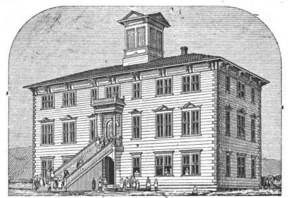Bishop Whitaker's School for Girls facts for kids
Bishop Whitaker's School for Girls was a special secondary school for girls in Reno, Nevada. It was located on a hill with a view of the Truckee River. This school was for both day students (who went home after classes) and boarding students (who lived at the school).
The school was started by an Episcopal bishop named Ozi William Whitaker. It welcomed students from 1876 until 1894.
How the School Started
The idea for the school began in 1875. A rich and generous woman from New York named Catharine Lorillard Wolfe offered $10,000 to start it. She said Bishop Whitaker needed to find the same amount of money from other people.
By the middle of 1876, enough money was collected. The Central Pacific Railroad also gave a piece of land for the school. The school officially opened on October 12, 1876. It was on the edge of town, surrounded by sagebrush. When it first opened, there were 50 students and 5 teachers. Kate A. Sill was the principal, or head, of the school.
Life at the School
By 1879, the school had a large, three-story building. It had a gym, classrooms, and special rooms for music lessons. The third floor had space for 40 boarding students to live.
The school taught classes all the way up to the twelfth grade. Students could learn about art, music, and foreign languages. They also learned domestic science, which taught them skills for managing a home.
In 1886, Bishop Whitaker moved away to Pennsylvania. Around the same time, the University of Nevada moved its campus closer to Whitaker's School. The University of Nevada did not charge tuition, and students from Nevada high schools did not need to take an entrance exam. Whitaker's School, however, cost up to $65 per month.
School Closing and What's Left
In 1894, Bishop Whitaker's School closed its doors. The old school building was then rented to the University of Nevada. It was used as a dorm for students until a new building, Lincoln Hall, was finished in 1896.
Later, the Washoe County School District used parts of the building for different classes. This happened when other school buildings were being built or fixed. The building was even turned into a hospital for a while. Eventually, the City of Reno bought the property.
The old school building was finally taken down. Today, there is a park called Whitaker Park where the school once stood.
One of the most famous students from Bishop Whitaker's School was Anne Henrietta Martin. She was a leader in the movement for women's right to vote. She was also the first woman to run for the United States Senate.
Images for kids



